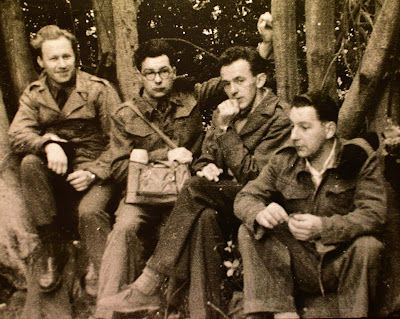Amazingly, neither of them were aware of this fact, even though they lived just a few miles apart in West London for over 70 years. Even more amazing given that Jerzy Kowalski's son Andrzej attended Polish Saturday school and Polish cubs and scouts with me for many years in the 1960s and '70s.
The funeral took place at Św. Andrzeja Boboli church in Hammersmith, my favourite Polish church in London (associations from childhood, better music). Whereas in Ealing we'd go to several different churches (POK, St Benedicts, St Matthews and latterly Windsor Road), for Poles in Acton, Chiswick and Hammersmith there was always, since the early 1960s, just the one - Boboli. The modernist sculptures and stained-glass windows, the memorials to Poland's wartime tribulations, make it a very special church for me - far more so than Windsor Road, which I associate more with the new wave of Polish migration that came since the end of communism.
The burial was at Gunnersbury cemetery, again, given the large number of Polish graves and the Katyń Memorial, a very special place for post-war Poles in London. The most poignant graves are of those Poles who'd fought in the war and died in London in the late 1980s, too early to see the restoration of Poland's independence.
Left: my father at the memorial. [This would be the last photograph I'd take of him; Bohdan Dembinski passed away on 29 October 2019, less than two weeks later.]
A particularly intriguing part of Jerzy Kowalski's life was his post-war membership of Brygadowe Koło Młodych „Pogoń” (Pogoń Brigade Youth Circle). This secret organisation was made up of men who'd served in the Polish armed forces during WW2. Its aim was to keep combat readiness in the event of the Cold War suddenly turning hot. The thinking within the Polish Government-in-Exile in London was to create and maintain a leadership cadre, versed in Polish military practice, that would serve much as the First Brigade did as Poland fought for its independence during WW1. Drawing on the model of the Cichociemni - the Silent and Unseen - the Polish commandos in the British Special Operations Executive in WW2, Pogoń was to form the basis of a Polish airborne division incorporated in NATO's military structures in time of war.
Below: Jerzy Kowalski (second from left) with comrades from Pogoń.
Below: on manoeuvres with Pogoń; Jerzy Kowalski (second from right)
In Cold War times, the existence of such an organisation was politically embarrassing to British governments, especially the Labour ones. As a result Pogoń drilled and trained in secret. Banned from wearing military uniforms, they'd parade in trench-coats and berets, a look later adopted by Frank Spencer. One fact that I learned at yesterday's funeral was that Jerzy Kowalski had carried out a number of parachute jumps with the French military in 1962 and 1963, earning his 'wings' (brevet Militair de Parachutiste). And all this while he was working as a chartered account with Thomson McLintock (since merged into KPMG) and the father of two small children. In the mid-70s (as a 50 year old), he completed the course to lead a company into battle. Promoted to the rank of captain, Jerzy Kowalski was ready to fight for Poland should the need have ever arisen.
The story of the Polish Government-in-Exile and its military is fascinating - those who kept faith with an independent Poland for the half-century of its occupation by the Nazis and then the communists.
CZEŚĆ JEGO PAMIĘCI!
This time last year:
Ideology and pragmatism
This time five years ago:
Nocturnal mists descend upon Jeziorki
This time seven years ago:
Heavy rain hits Warsaw
This time nine years ago:
The autumn sublime in Warsaw
This time 11 years ago:
Lublin and its charm









1 comment:
This is a remarkable story of courage and hope. Thank you for sharing.
Post a Comment